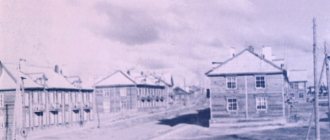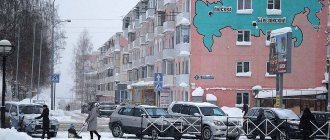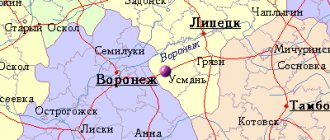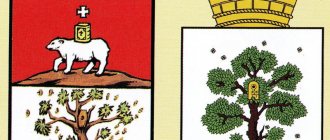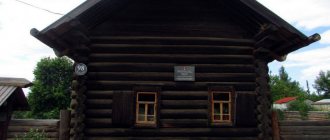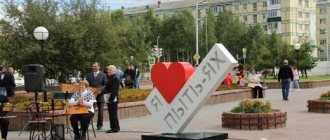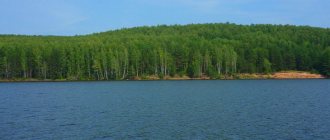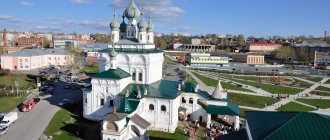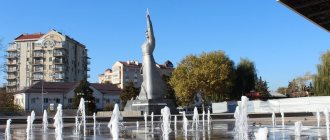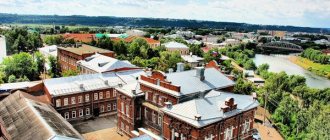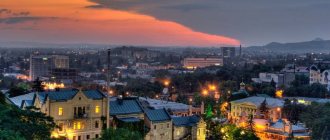City in Sverdlovsk Oblast, Russia
City in Sverdlovsk Oblast, Russia
| Krasnouralsk Krasnouralsk | |
| City [1] | |
| In Krasnouralsk | |
| Flag Coat of arms | |
| Location of Krasnouralsk | |
| Krasnouralsk Location of Krasnouralsk Show map of Russia Krasnouralsk Krasnouralsk (Sverdlovsk region) Show map of Sverdlovsk region | |
| Coordinates: 58°21'N 60°03'E / 58.350°N 60.050°E / 58,350; 60.050 Coordinates: 58°21'N 60°03'E. / 58.350°N 60.050°E / 58,350; 60,050 | |
| A country | Russia |
| Federal subject | Sverdlovsk region [1] |
| Based | 1832 |
| City status from | 1932 |
| Height | 220 m (720 ft) |
| population size (2010 Census) [2] | |
| • General | 24 980 |
| • Evaluate (2018) [3] | 22 996 ( -7,9% ) |
| Administrative status | |
| • Subordinate | City of Krasnouralsk [1] |
| • Capital from | Krasnouralsk [4] |
| Municipal status | |
| • Urban district | Krasnouralsk urban district [5] |
| • Capital from | Krasnouralsk urban district [6] |
| Timezone | UTC+5 (MSK+2[7]) |
| Postal code [8] | 624330, 624332–624335 |
| Dialing code(s) | +7 34343 |
| OKTMO ID | 65746000001 |
Krasnouralsk population
| 2010 Census | 24 980 [2] |
| 2002 Census | 28 961 [9] |
| 1989 Census | 35 284 [10] |
| 1979 Census | 38 235 [11] |
Krasnouralsk
(Russian: Krasnouralsk) is a city in Sverdlovsk Oblast, Russia. At the 2010 census its population was 24,980. [2]
History[edit]
The first settlement on the site of the future Krasnouralsk was formed in 1832. At first, the residents' efforts were aimed at meeting the needs of factories and preparing charcoal. In the 1820s, gold mining began on the Salda River and its sources: more than 100 mines were opened. In 1843, deposits of copper pyrite were discovered on the Kushayka River. And in 1875, the development of gold ore began in the mines of the merchant I.P. Bogomolov, after whom the famous Bogomolovskoe copper-pyrite deposit was later named. [12] In 1925, construction of the country’s largest copper smelter began on the basis of the Bogomolovskoye deposit, in connection with the start of development of the Krasnogvardeyskoye copper ore deposit, along with which the construction of a workers’ village of the same name began. and the construction of a smelter, the village of Bogomolstroy was founded. In 1929 it was renamed Uralmedstroy (Russian: УралмедсьTRO). [ citation needed
] In 1931, the plant was put into operation.
In 1931, Uralmedstroy received the status of a workers' village and was renamed Krasnouralsk. [ citation needed
] City status was granted in 1932. [13]
At the time construction began, “there were only three residential buildings at the Krasnogvardeisky mine and two houses at Kushayk. At the 16th Party Congress, one of the leaders of the economic complex of the Ural region, V.N. Andronikov, complained about pests, in particular, about the delay in the start-up of the Krasnouralsk plant. [14]
Krasnouralsk included a metallurgical plant village and two mining villages, Krasnogvardeisky and Novo-Levinsky, located in close proximity. All these villages and industrial facilities (to which should be added the chemical plant under construction) constituted a single city.
Construction of a modern city[edit]
The city center was a rectangular factory square formed by Lenin and Kirov streets and stretching from northwest to southeast. A three-story factory building and factory passages overlooked the square from the southeast. Around the square, judging by the not entirely correct radial arrangement of the beams, there is a factory village, completely built in the 30s of the last century. And almost completely (minus, of course, the barracks buildings) have been preserved to this day, right down to utility sheds in the courtyards of two-story houses.
Public infrastructure was located in the southern part of the city in relation to the factory territory, along two streets leading to the Mednaya railway station - Sovetskaya and Kalinina.
There was a city council, a bank, a technical school, a bathhouse, and a department store. The surviving capital buildings are two-story, since there were no three-story residential buildings in Krasnouralsk, with the exception of a large engineering building in the northern part.
It was assumed that the socialist city would be completed simultaneously with the plant. Social and cultural construction was planned according to the capital construction plan for 1931 [15]
As in most cases at other construction sites, preparing the plant for the start absorbed all the resources and strength of the builders. Housing and communal services were abandoned. In 1931, the Krasnouralsk water pipeline was launched, stretching 11 km to the Tura River.
On November 14, 1931, a large editorial appeared in the Gigant newspaper: “The socialist plant needs a socialist city.” Determination of current construction tasks. In 1931, plans were made to add 60 houses, a clubhouse, a bathhouse, a public works station and a department store. In 1932, 125 new houses, sewerage, public workplace No. 2, two cinema clubs, a laundry, a kitchen factory, a hospital campus, several canteens, kindergartens and nurseries). [16]
World War II[edit]
At the beginning of the Great Patriotic War, construction of a chemical plant began on the territory of Krasnouralsk. On instructions from the government, in the last month of the summer of 1941, a defense workshop was built, within the walls of which shells for the Katyusha were made. Krasnouralsk residents replenished the country's defense fund by 27 million rubles, which were used for the construction of the Krasnouralsky Master and Soviet Copper aircraft, as well as for air traffic in Krasnouralsk.
Post-war[edit]
On July 30, 1957, to better organize the work of all production units, the Krasnouralsk Copper Smelter was created, uniting the Krasnouralsk Mining Administration, chemical and copper plants. Georgy Baiderin was appointed head of the plant. In 1993, the city-forming enterprise was transformed into OJSC Svyatogor as part of UMMC-Holding.
On February 1, 1963, the Council of Workers' Deputies of the city of Krasnouralsk was subordinated to the Sverdlovsk Regional Council of Workers' Deputies. [17]
Attractions
Krasnouralsk Museum of Local Lore
The museum appeared in 1960 at the city-forming enterprise as a technical office. Over time, the museum grew into a historical and industrial museum, where they began to hold exhibitions, excursions, and meetings. In 2009, the museum became a city museum: it began to tell not only about the metallurgical plant, but also about the history of the city.
Museum of Local Lore, City of Krasnouralsk
Today the museum contains more than 2 thousand different exhibits and can tell the history of the exploration and development of Krasnouralsk , about the life and traditions of the Russian people, the civil war and the participation of Krasnouralsk residents in it. Also in the museum there is a hall of the history of the construction of the copper smelter, a military hall, and a hall of the Svyatogor OJSC .
Krasnouralsk Museum of Local Lore
Address: Krasnouralsk, st. Sovetskaya 2 Opening hours: Monday - Friday from 9.00 to 18.00, lunch from 12.00 to 13.00 Phone: +7 (34343) 27-0-71 Social networks: VKontakte
Big Balaban Stone
The Bolshoy Balaban stone is located on the territory of the Krasnouralsk urban district on the left bank of the Tagil River , 3 kilometers from the village of Yasva . According to legend, the village became a short-term stop for Ermak and his squad during the campaign to Siberia in 1582.
Photo source: Teppitopia RUS
Big Balaban is considered a geomorphological and botanical natural monument and occupies 5 hectares. It was formed in 1983 in order to provide the necessary protection of unique limestone rocks and a complex of rock flora.
The word "balaban" translated from the language of the Crimean Tatars and Turkish means - with a large head or a kind of bird of prey, and Balaban , according to scientists, is a cult place of ancient people.
John-Sergius Church
The formation of the city of Krasnouralsk occurred in the atheistic era. Therefore, the first Christian church appeared here in the 20th century, after the revival of Orthodox traditions and the revaluation of Orthodoxy in the history and culture of the country. Stroitel Palace of Culture , which at that time had neither windows nor floors, was given over to the temple Father Sergius Ponomarev was appointed rector , through whose spiritual and physical labors the old building acquired a church appearance.
In 1998, Archpriest Vladimir Eliseev , under whose supervision the iconostasis and baptismal room, altar, and choir were updated in the church; courtyard facilities and a stone fence were built; two rooms were renovated for a parochial school.
Today the temple can be considered one of the most beautiful in the Sverdlovsk region .
Links[edit]
Notes[edit]
- ^ abcde Order No. 120-P
- ^ abc Federal State Statistics Service (2011). “All-Russian Population Census 2010. Volume 1" [All-Russian Population Census 2010, vol. 1]. All-Russian Population Census 2010 [All-Russian Population Census 2010]
. Federal State Statistics Service. - "26. The size of the permanent population of the Russian Federation by municipalities as of January 1, 2022". Federal State Statistics Service. Retrieved January 23, 2022.
- State Committee of the Russian Federation on Statistics. Committee of the Russian Federation for Standardization, Metrology and Certification. No. OK 019-95 January 1, 1997 “All-Russian classifier of objects of administrative-territorial division. Code 65 460", ed. changes No. 278 / 2015 dated January 1, 2016. (Goskomstat of the Russian Federation. Committee of the Russian Federation for Standardization, Metrology and Certification. No. OK 019-95 January 1, 1997. Russian classification of administrative divisions) (OKATO).
Code 65 460 , as amended by Amendment No. 278/2015 of 01/01/2016). - ^ ab Law No. 85-OZ
- Federal State Statistics Service. Federal Agency for Technological Regulation and Metrology. No. OK 033-2013 January 1, 2014 “All-Russian classifier of municipal territories. Code 65 746 ". (Federal State Statistics Service. Federal Agency for Technological Regulation and Metrology. No. OK 033-2013 January 1, 2014. Russian classification of municipal territories. Code 65 746.
). - "On the Calculation of Time". Official Internet portal of legal information
. June 3, 2011. Retrieved January 19, 2022. - Post office. Information and computing center of OASU RPO. ( Post office
).
Search for postal service objects ( postal Search for objects
) (in Russian) - ↑
Federal State Statistics Service of Russia (May 21, 2004).
“The population of Russia, the constituent entities of the Russian Federation as part of federal districts, urban settlements, settlements, settlements is 3 thousand or more people” [Population of Russia, its federal districts, federal districts, districts Urban settlements, rural settlements - administrative centers and rural settlements with a population of over 3,000] (XLS). All-Russian Population Census 2002
. - “All-Union Population Census of 1989. The current population of union and autonomous republics, autonomous regions and districts, territories, negative phenomena, urban settlements and rural district centers” [All-Union Population Census of 1989: current population of union and autonomous republics, Autonomous regions and districts , territories, regions, districts, towns and villages performing the functions of district administrative centers. All-Union Population Census of 1989 [All-Union Population Census of 1989]
.
Institute of Demography of the National Research University: Higher School of Economics [Institute of Demography of the National Research University: Higher School of Economics]. 1989 - via Demoscope Weekly
. - “All-Union Population Census of 1979. National composition of the population by regions of Russia” [All-Union Population Census of 1979. Ethnic composition of the population by regions of Russia] (XLS). All-Union Population Census of 1979 [All-Union Population Census of 1979]
.
1979 - via Demoscope Weekly
(website of the Institute of Demography of the State University - Higher School of Economics. - Our Ural. “The city of Krasnouralsk: history, sights, photos” (url). Retrieved March 1, 2022.
- Our Ural. “The city of Krasnouralsk: history, sights, photos” (url). Retrieved March 1, 2022.
- XVI Congress of the CPSU (b), p. 530
- Krasnouralsk. Capital construction plan for 1931
- Our Ural. “The city of Krasnouralsk: history, sights, photos” (url). Retrieved March 1, 2022.
- ipravo.info. “On the consolidation and denial of sexual activity in the city of the Sverdlovsk region” (in Russian). ipravo.info. Archived from the original on May 20, 2022. Retrieved May 20, 2018.
- Law No. 30-OZ
Krasnouralsk
(Sverdlovsk region)
OKATO code:
65460
Founded:
1925
Urban settlement since:
1931
City since:
1932 City of regional subordination
The city was formerly called:
| Uralmedstroy | 1925 | 1932 |
| Telephone code (reference phone) | |
| 34343***** | 22-0-20 |
Deviation from Moscow time, hours:
2
Geographic latitude:
58°21′
Geographic longitude:
60°03′
Altitude above sea level, meters:
220 Sunrise and sunset times in the city of Krasnouralsk
